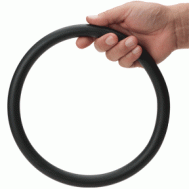When you want to learn more about a process at Apple Rubber, it’s best to go directly to the source.
For this primer on thermobonding — “Apple Rubber’s breakthrough manufacturing process for large O-rings and seals, (a) unique process (that) molds the joint with proprietary adhesives and cures with little to no mismatch while providing excellent flexibility in MacrOring® seals” — we spoke to Joe Cius, thermobond department manager.
Explain what thermobonding is meant to do.
Joe Cius: We make O-rings. It’s a two-part process involving splicing and vulcanizing to customer specifications.
What sizes are available? How big or small can these O-rings be?
JC: The smallest size is around an inch and a half in diameter, and the largest can go around your house.
What stock of cross sections and materials do you carry? What are limitations, if any, to fulfilling a request? within Apple Rubber’s capabilities?
JC: We always try to meet the customer’s requirements. We carry some stock — any materials that we don’t have, we go to our suppliers. Depending what the customer’s specs are, we can get it in here quickly. As long as we can get the material, like Viton, Buna-N, Epichlorohydrin, etc., we can make an O-ring out of it. The fact that we have that capability, that’s something we can do for a customer to help them if they are in a jam.
What is the difference between thermobond and cold bond?
JC: In thermobond, we heat up molds to approximately 325 to 350 degrees. You cut the material to size, and then apply non-cured type adhesive to the ends — that’s the splice. Then the vulcanizer uses heat and pressure to cure and seal the ring.
As for cold bond — the most popular is actually Crazy Glue. Cold bonds are not vulcanized — they’re simply allowed to dry. You flip the rings around and pull them, one by one, (and) put them together. Various cold bond adhesives hold well, but not as well as Crazy Glue. And with cold bond, there is less flex — it might not fit as well.
So when would you use cold bond?
JC: You might use cold bond if, for example, you are having problems in field. You take a tube of glue, make a seal, and get through a situation. It’s more of a stopgap.
It is also good when you don’t want the ring to have marks. Vulcanizing can do that, for example, on a material like sponge cord.
What is the preferred splice cut angle?
JC: Butt cut or straight cut is the most common. When you cut at a 45-degree angle, you create more surface area, and, theoretically, you can get a better seal.
How are MacrOrings created?
JC: Sometimes, if the diameter is so large, you might have to double splice. One usage for such a large ring is in an oil tank lid. Customers are usually happy that we can get the product to them.
